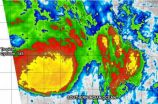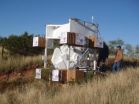(Press-News.org) The fourteenth tropical cyclone of the Southern Indian Ocean season was born as NASA's Terra satellite passed overhead.
On February 7 at 0900 UTC/4 a.m. EST, Tropical Cyclone 14S had maximum sustained winds near 35 knots/40 mph/62 kph. It was located about 814 nautical miles/936.7 miles/1,508 km east-northeast of Port Louis, Mauritius near 14.8 south and 70.4 east. At that time, 14S was moving to the south near 8 knots/9.2 mph/14.8 kph.
The Joint Typhoon Warning Center noted that multispectral satellite imagery showed that the low-level center is exposed to outside winds and that the center is actually elongated (not a good thing for maintaining strength).
NASA's Terra satellite passed over Tropical Cyclone 14S on February 7 and the Moderate Resolution Imaging Spectroradiometer or MODIS instrument captured infrared data. Cloud top temperatures in excess of -70C/-94F were seen north of the center of circulation indicating strong convection and powerful thunderstorms.
14S has since turned to the southeast and is expected to intensify a little before turning southwest and weakening.
INFORMATION:
Text credit: Rob Gutro
NASA's Goddard Space Flight Center
NASA spots fourteenth tropical cyclone of Southern Indian Ocean season
2014-02-08
ELSE PRESS RELEASES FROM THIS DATE:
Thinking skills take biggest hit from anxiety in midlife women with HIV
2014-02-08
CLEVELAND, Ohio (Friday, February 7, 2014)—Hot flashes, depression, and most of all, anxiety, affect the thinking skills of midlife women with HIV, so screening for and treating their anxiety may be especially important in helping them function, according to a study just published online in Menopause, the journal of The North American Menopause Society (NAMS). The reproductive stage, whether it was premenopause, perimenopause or postmenopause, did not seem to be related to these women's thinking skills.
The conclusions come from a new analysis of data on 708 HIV-infected ...
WASP gives NASA's planetary scientists new observation platform
2014-02-08
Scientists who study Earth, the sun and stars have long used high-altitude scientific balloons to carry their telescopes far into the stratosphere for a better view of their targets. Not so much for planetary scientists. That's because they needed a highly stable, off-the-shelf-type system that could accurately point their instruments and then track planetary targets as they moved in the solar system.
That device now exists.
NASA's Wallops Flight Facility in Wallops Island, Va., has designed a new pointing system — the Wallops Arc Second Pointer (WASP) — that can point ...
Study provides surprising new clue to the roots of hunger
2014-02-07
BOSTON – While the function of eating is to nourish the body, this is not what actually compels us to seek out food. Instead, it is hunger, with its stomach-growling sensations and gnawing pangs that propels us to the refrigerator – or the deli or the vending machine. Although hunger is essential for survival, abnormal hunger can lead to obesity and eating disorders, widespread problems now reaching near-epidemic proportions around the world.
Over the past 20 years, Beth Israel Deaconess Medical Center (BIDMC) neuroendocrinologist Bradford Lowell, MD, PhD, has been untangling ...
New method developed for ranking disease-causal mutations within whole genome sequences
2014-02-07
Seattle, Wash. and Huntsville, Ala.—Researchers from the University of Washington and the HudsonAlpha Institute for Biotechnology have developed a new method for organizing and prioritizing genetic data. The Combined Annotation–Dependent Depletion, or CADD, method will assist scientists in their search for disease-causing mutation events in human genomes.
The new method is the subject of a paper titled "A general framework for estimating the relative pathogenicity of human genetic variants," published in Nature Genetics.
Current methods of organizing human genetic variation ...
Study identifies protein to repair damaged brain tissue in MS
2014-02-07
Vittorio Gallo, PhD, Director of the Center for Neuroscience Research at Children's National Health System, and other researchers have found a "potentially novel therapeutic target" to reduce the rate of deterioration and to promote growth of brain cells damaged by multiple sclerosis (MS). Current therapies can be effective in patients with relapsing MS, but have little impact in promoting tissue growth.
The brain produces new cells to repair the damage from MS years after symptoms appear. However, in most cases the cells are unable to complete the repair, as unknown ...
Analysis of calls to IBD clinic predicts emergency visits and hospitalizations, Pitt finds
2014-02-07
PITTSBURGH, Feb. 7, 2014 – A comprehensive analysis of patient telephone records at an inflammatory bowel disease (IBD) clinic revealed that 15 percent of patients account for half of all calls to the clinic. Forty-two percent of frequent-caller patients also were seen in the emergency department or hospitalized within the following year.
The results, which can help doctors identify patients with the most severe disease and those at risk of potentially avoidable high-cost medical interventions, were reported in a study published online this week in the journal Clinical ...
Ice age's arctic tundra lush with wildflowers for woolly mammoths, study finds
2014-02-07
MANHATTAN, Kan. -- A recent study in the journal Nature finds that nearly 50,000 years ago during the ice age, the landscape was not as drab as once thought -- it was filled with colorful wildflowers. These wildflowers helped sustain woolly mammoths and other giant grazing animals.
The study, "Fifty thousand years of Arctic vegetation and megafauna diet," included Joseph Craine, assistant professor in the Division of Biology at Kansas State University. It was led by the Centre for GeoGenetics at the University of Copenhagen and was a collaboration of more than 25 academic ...
Bottom-up insight into crowd dynamics
2014-02-07
Stampedes unfortunately occur on too regular a basis. Previously, physicists developed numerous models of crowd evacuation dynamics. Their analyses focused on disasters such as the yearly Muslim Hajj or of the Love Parade disaster in Germany in 2010. Unfortunately, the casualties at these events may have been linked to the limitations of the crowd dynamics models used at the time. Now, a new study outlines a procedure for quantitatively comparing different crowd models, which also helps to compare these models with real-world data. In a paper published in EPJ B, Vaisagh ...
Researchers use genetic signals affecting lipid levels to probe heart disease risk
2014-02-07
New genetic evidence strengthens the case that one well-known type of cholesterol is a likely suspect in causing heart disease, but also casts further doubt on the causal role played by another type. The findings may guide the search for improved treatments for heart disease.
Most of us have heard of "good cholesterol" and "bad cholesterol" coursing through our bloodstream. In the conventional health wisdom of the past 30 years, having more of the "good" variety (high-density lipoprotein, or HDL) lowers your risk of heart disease, while more of the bad one (low-density ...
Shape-sifting: NIST categorizes bio scaffolds by characteristic cell shapes
2014-02-07
Getting in the right shape might be just as important in a biology lab as a gym. Shape is thought to play an important role in the effectiveness of cells grown to repair or replace damaged tissue in the body. To help design new structures that enable cells to "shape up," researchers at the National Institute of Standards and Technology (NIST) have come up with a way to measure, and more importantly, classify, the shapes cells tend to take in different environments.*
With the notable exception of Flat Stanley, we all live, and are shaped by, a 3-dimensional world. Biologists ...


